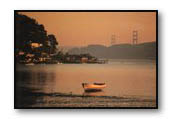|
Expedition 2: What Goes In?
 In this activity, your team goes undercover to investigate the health of the marine and estuary environment in either the San Francisco or Tokyo Bay. You will publish your findings in a news magazine and also host a press conference to summarize your results.
In this activity, your team goes undercover to investigate the health of the marine and estuary environment in either the San Francisco or Tokyo Bay. You will publish your findings in a news magazine and also host a press conference to summarize your results.
Your team’s goal is to create an “award-winning” piece of print journalism. Many of your readers may not be aware of the health of their bay environment. You can use the links provided below to help you include the following facts and information in your news article:
- History of urban development. How has population growth and industrialization changed the Bay in the last 100 years?
- What toxic substances enter the Bay? From what sources? What is the effect on human life? On wildlife?
- What is the history of oil spills on the Bay?
- What “accidental tourists” (non-native aquatic species) have taken up residence in the Bay? How have these species altered the local ecosystem?
- What can individuals living near the Bay do to protect, preserve and restore the marine environment?
- What laws and policies do you think need to be enacted to protect, preserve and restore the marine environment?
For your presentation, consider the following roles on your team:
- Editor(s): This role helps choose story topics, organize stories into a related whole, and writes editorial columns with a distinct point-of-view.
- Investigative Journalist(s): This role investigates story topics, assembles background information and different viewpoints, and writes a story that deepens understanding about an issue.
- Graphic Designer(s): This role prepares illustrations, maps and charts to visualize the findings of your team.
- Cartoonist: This role draws a cartoon that brings irony and/or humor to an issue.
 Your final presentation should be structured like a live press conference. You may want to prepare a press release and consider ways to dramatize your findings.
Your final presentation should be structured like a live press conference. You may want to prepare a press release and consider ways to dramatize your findings.
Activity Links
Tokyo Bay
The News-Journal, EnviroLinks
Articles about the July 1997 oil spill in Tokyo Bay.
Recycling – A Solution? Coping with Tokyo’s Mountain of Waste
Tokyo’s huge amount of household waste has been used to build islands, which seep pollutants into the bay.
Tokyo, Water City
Renewed enthusiasm for Tokyo’s waterways and waterfront have led to a clean up of the Sumida River.
San Francisco Bay
Current Pollutant Loads and Trends
San Francisco Bay’s high pollutant load and efforts to reduce input to the water.
US Geological Survey Pollution Study
A study on the effects of human-related inputs into the San Francisco Bay. Includes a map of toxic sites surrounding the Bay.
Bioinvasion Rates
One of the most invaded aquatic environments in the world, the San Francisco Bay is home to an increasing number of non-native organisms and fish.
SF Estuary Project
Watershed map of the San Francisco Bay and Delta and information on what goes into estuary.
California Department of Oil Spill Prevention and Response
News releases on California oil spills, including maps and photographs.
Bay Area EcoAtlas
Historic and current maps of the San Francisco Bay and Delta.
US Geological Survey
Urban development map animation of the San Francisco Bay Area.

